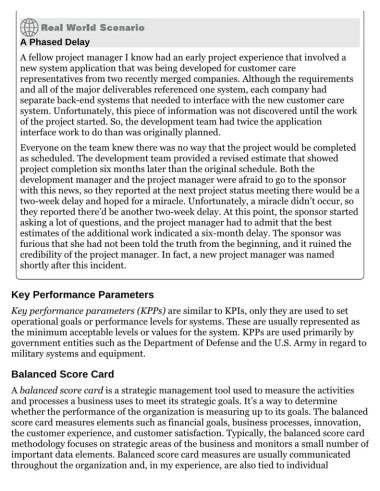Page 297 - Project+
P. 297
A Phased Delay
A fellow project manager I know had an early project experience that involved a
new system application that was being developed for customer care
representatives from two recently merged companies. Although the requirements
and all of the major deliverables referenced one system, each company had
separate back-end systems that needed to interface with the new customer care
system. Unfortunately, this piece of information was not discovered until the work
of the project started. So, the development team had twice the application
interface work to do than was originally planned.
Everyone on the team knew there was no way that the project would be completed
as scheduled. The development team provided a revised estimate that showed
project completion six months later than the original schedule. Both the
development manager and the project manager were afraid to go to the sponsor
with this news, so they reported at the next project status meeting there would be a
two-week delay and hoped for a miracle. Unfortunately, a miracle didn’t occur, so
they reported there’d be another two-week delay. At this point, the sponsor started
asking a lot of questions, and the project manager had to admit that the best
estimates of the additional work indicated a six-month delay. The sponsor was
furious that she had not been told the truth from the beginning, and it ruined the
credibility of the project manager. In fact, a new project manager was named
shortly after this incident.
Key Performance Parameters
Key performance parameters (KPPs) are similar to KPIs, only they are used to set
operational goals or performance levels for systems. These are usually represented as
the minimum acceptable levels or values for the system. KPPs are used primarily by
government entities such as the Department of Defense and the U.S. Army in regard to
military systems and equipment.
Balanced Score Card
A balanced score card is a strategic management tool used to measure the activities
and processes a business uses to meet its strategic goals. It’s a way to determine
whether the performance of the organization is measuring up to its goals. The balanced
score card measures elements such as financial goals, business processes, innovation,
the customer experience, and customer satisfaction. Typically, the balanced score card
methodology focuses on strategic areas of the business and monitors a small number of
important data elements. Balanced score card measures are usually communicated
throughout the organization and, in my experience, are also tied to individual
297

